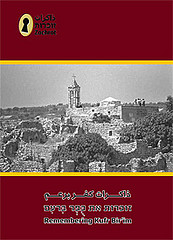Aerial photo – Norma Musih
8.10.1949 Photograph taken by the Israeli Ministry of Agriculture.
The village in the photo is empty of inhabitants. Members of Kibbutz Bar'am already have moved into a few of the buildings. In the northern part of the village, where the threshing floor was located, the color is darker, a sign of vegetation, indicating that the threshing floor was no longer in use. Signs of vehicular traffic are visible at the entrance to the village, perhaps military vehicles belonging to Haganah forces which had taken over a large structure at the village entrance which had previously been confiscated by the British police. Tire tracks crate a new dirt road running northeast. It apparently leads to Kibbutz Bar'am, established at the same time not far from the village, on its lands and on those belonging to the village of Farah. The church appears in the center of the photograph, barely distinguishable from its surroundings (In 1972 the place was declared a closed military area, and the residents of Bir'im were forbidden to visit. Only in 1973, after many legal battles, were the villagers able to return to visit the church and the village cemetery). Near the church you can see an excavation where German archaelogists began digging in the early twentieth century. The excavations were carried out as village life continued, not instead of it. The archaeological site, like the church, appears in the photograph surrounded by the houses of the village, as an integral part of it. From the time the photograph was taken until the village was bombed in 1953, it existed in suspended animation, and all new construction toward the main road came to a halt.
Preface
By Al-Awda Youth
On Tuesday, November 25th, 2009, officials from the regional council of Merom Hagalil in the north of Israel demolished a building in the depopulated Palestinian village of Kafr Bir'im in the north of Israel. The building, which was constructed two months ago during a volunteer working camp at the site, was supposed to serve these refugees as a restroom and bathroom during their presence at the village for their political and religious activities.
The people of Kafr Bir'im, who currently live as refugees in various places in Israel, Jordan and Lebanon since the ethnic cleansing of 1948, received the news of the demolition with anger and sadness. Two months ago, more than 70 volunteers of first, second and third generation refugees from the village participated in the volunteer working camp, which takes place every year in the remainings of the village that was bombed by Israeli warplanes in 1953.
The authorities of Merom Hagalil Regional Council placed a demolition order on the building a month ago, deeming it as an illegal construction. However, the building was constructed on land adjacent to the church, which makes it a property of the Christian religious authority.
According to a press release made by Al-Awda [the Return], a youth group of second and third generation refugees from Kafr Bir'im who now reside in Israel, "these repressive attempts aim to terrorize us and to prevent us from continuing our struggle to return to our village. This policy is not new; it is the direct continuation of the same policy that depopulated our village in 1948."
According to Al-Awda, this recent demolition constitutes an act of a "political revenge," for the latter generations of refugees from Karf Bir'im maintain the "spirit of Return" of their parents and grandparents who were depopulated from the village in 1948."Such measures can only make us stronger," the press release concluded, for the authorities "will never prevent us from continuing to build and construct until the day we return to our beloved village."
Village Today
According to the Palestinian historian Walid Khalidi, the remaining structures on the village land are:
The village has been demolished. The only standing structure is the church and its belltower. Crumbled walls, some scattered, partially-collapsed houses, and extensive rubble cover the hillside, all overgrown with bushes and wild grasses. Some of the archaeological remains are still visible. The village site has been closed off and the surrounding area declared an archaeological and tourist site
Download File



